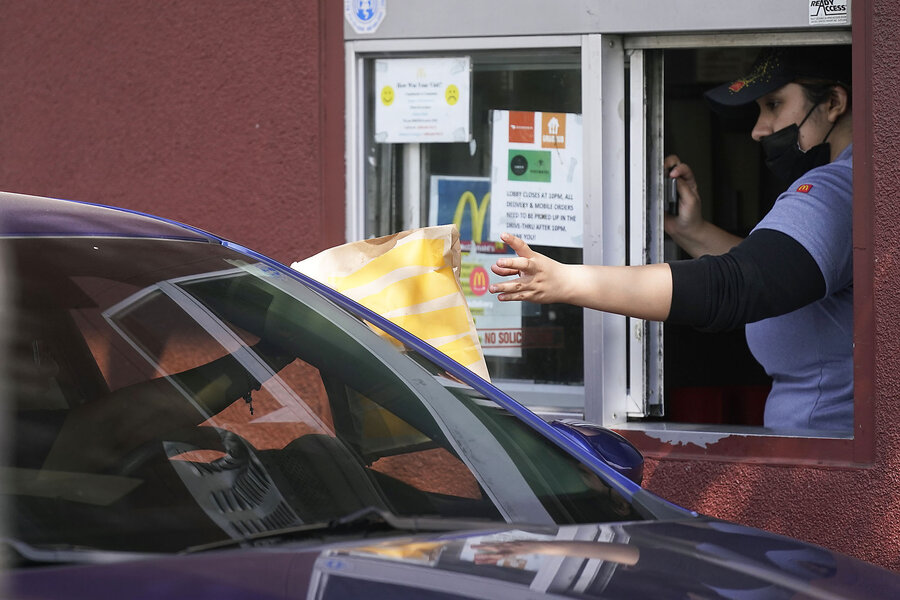Minimum wages rise: Here’s where the changes matter most
Loading...
Grace Champagne makes $18.50 an hour, plus a portion of tips, working as a host at a chain restaurant. That’s nearly $2 over minimum wage in San Diego, where she goes to school. In this tight California job market, the college student asked for the hourly bump, and got it. The extra bit goes into Ms. Champagne’s savings to eventually help repay college loans.
“It seems like a small difference, but it makes a really big difference,” says Ms. Champagne, who struggles to keep up with California’s high cost of living.
Why We Wrote This
The idea behind raising base pay closer to a “living wage” – pay that covers basic expenses – is that it builds better communities. But some businesses say the increases push them to the brink.
Across the United States, workers like Ms. Champagne are seeing an uptick in hourly wages. Twenty-two states raised their minimum wages last month, affecting nearly 10 million workers. Many of these increases were in the works years ago, as part of multiyear legislative packages. Some states tie the increases to inflation. Others, mostly in the South and Midwest, follow the federal minimum of $7.25 per hour, which hasn’t changed since 2009.
State minimum wages have risen faster than inflation for many workers since 2009, despite stagnation in federal policy. But across the country, minimum wages still fall consistently below what economists call living wages – the amount needed to meet a person’s, or family’s, basic needs.
Grace Champagne makes $18.50 an hour, plus a portion of tips, working as a host at a chain restaurant. That’s nearly $2 over minimum wage in San Diego, where she goes to school. In this tight California job market, the college student asked for the hourly bump, and got it. The extra bit goes into Ms. Champagne’s savings to eventually help repay college loans.
“It seems like a small difference, but it makes a really big difference,” says Ms. Champagne, who struggles to keep up with California’s high cost of living.
Across the United States, workers like Ms. Champagne are seeing an uptick in hourly wages. Twenty-two states raised their minimum wages last month, affecting nearly 10 million workers. Many of these increases were in the works years ago, as part of multiyear legislative packages. Some states tie the increases to inflation. Others, mostly in the South and Midwest, follow the federal minimum of $7.25 per hour, which hasn’t changed since 2009. The wide variances create a cross-country picture that is at once mixed and nuanced.
Why We Wrote This
The idea behind raising base pay closer to a “living wage” – pay that covers basic expenses – is that it builds better communities. But some businesses say the increases push them to the brink.
The notion of having a minimum wage, say experts, is to have a pay floor that allows for a basic living standard. That living standard, however, varies from city to town and from state to state. Work philosophies and politics also come into play.
“It really is a reflection of what the body politic in the jurisdiction feels is the minimum that they would like to see any worker in that jurisdiction be paid per hour,” points out economist Jerry Nickelsburg, director of the University of California, Los Angeles’ Anderson Forecast.
Closing the gap
State minimum wages have risen faster than inflation for many workers since 2009, despite stagnation in federal policy. But across the country, minimum wages still fall consistently below what economists call living wages – the amount needed to meet a person’s, or family’s, basic needs.
While many minimum wage workers are unskilled teens, the vast majority of workers who benefit from minimum wage hikes are over the age of 20, according to research by the Economic Policy Institute.
The living wage varies widely among jurisdictions, driven in large part by the cost of housing. The states where minimum wages are highest are the same states where, despite higher costs, the lowest wage earners are within reach of a living wage. Alternatively, the states with lower costs also tolerate the lowest minimum wages – and have the largest gap for low-wage workers to make up.
“We still have large numbers of workers who do not earn enough to meet their family’s basic needs,” says Ken Jacobs, who co-chairs the University of California, Berkeley’s Labor Center. He adds, “The preponderance of academic research finds that minimum wage laws do what they’re intended to do. They improve low-wage workers’ earnings, which has a full range of positive impacts, both on workers and on society.”
Connecticut has the narrowest gap between minimum and living wages: A single person with no children working full time at $15.69 per hour is 12% shy of a living wage. Georgia, where the minimum wage is $7.25 per hour, has the largest gap: 59%. In all states, the gaps are much bigger for workers with children.
Intervention at the policy level, says Professor Jacobs, recognizes an ongoing, outsize power that employers hold in the workplace. The more workers earn, the more they spend in the local economy, “and that’s good overall, for our local economies, and it’s vital for workers to be able to meet their basic needs,” he says.
“Ready to give up”
California’s minimum wage is $16 per hour, with some cities raising it higher ($19.08 in West Hollywood). The state calls on specific industries, also, to raise their wages in the months and years ahead: In April, California’s fast-food workers go to $20 per hour, and by 2026, health care workers will make at least $25 per hour.
Business owners here say that they are feeling squeezed. With the country’s low 3.7% unemployment rate, many businesses are already paying above minimum wage for jobs that historically fit that category. The increased labor cost, added to a jump in costs for goods, insurance, and other operational expenses, means that many employers are struggling to emerge from a pandemic slump that caused many to shut their doors for good.
The landscape, in a word, is uncertain, according to John Kabatek, California director for the National Federation of Independent Business.
“Small-business owners in California are frightened, scared, and frustrated that policymakers are doing next to nothing to help them emerge from that COVID hole,” says Mr. Kabatek. “Add to that the legislature’s inaction on retail theft and property crimes, and small-business owners have good reason to feel ... ready to give up.”
Lumber and hardware store owner Jeff Pardini says those minimum wage hikes translate to increased costs across the board. It’s “death by a thousand cuts,” he says.
Back in San Diego, Ms. Champagne says she and her friends are still having a tough time keeping up with expenses. Those who work in the fast-food industry, especially, are looking forward to the April pay raise.
She says she needs her job – and would work at the lower rate, but the extra bit is a big help. “Before I was waiting on checks to be able to get gas and do other things,” she says. “But with this, I have a little extra wiggle room.”











